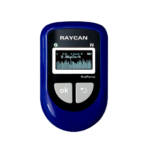 Scientific Reports published a new study from researchers at the Lawrence Berkeley National Laboratory (Berkeley Lab) examining the risk of mammary cancer in mice from low-dose radiation, which the researchers defined as 100 millisieverts (mSv).
Scientific Reports published a new study from researchers at the Lawrence Berkeley National Laboratory (Berkeley Lab) examining the risk of mammary cancer in mice from low-dose radiation, which the researchers defined as 100 millisieverts (mSv).
For most mice, low-dose radiation had no effect on their risk of cancer. Some even gained more protection from cancer after the dose. However, the other end of the spectrum occurred as well, with some mice becoming more susceptible. Of those mice, the scientists identified thirteen genetic loci that contribute to tumor susceptibility. The researchers hope to find similar loci in humans in the future, eventually developing tests to distinguish those with higher risk of cancer from low-dose radiation.
 X-Z LAB believes that staying informed about your exposure is critical to your safety and well-being. With a dose rate range of 0.01 µSv/h–1 mSv/h and an integrated dose range of 0.01 µSv–100 Sv, RadPavise | Personal Radiation Detector and RadTarge II | Electronic Personsal Dosimeter allow you to keep track of even the lowest doses of radiation.
X-Z LAB believes that staying informed about your exposure is critical to your safety and well-being. With a dose rate range of 0.01 µSv/h–1 mSv/h and an integrated dose range of 0.01 µSv–100 Sv, RadPavise | Personal Radiation Detector and RadTarge II | Electronic Personsal Dosimeter allow you to keep track of even the lowest doses of radiation.
Abstract
The interplay between host genetics, tumor microenvironment and environmental exposure in cancer susceptibility remains poorly understood. Here we assessed the genetic control of stromal mediation of mammary tumor susceptibility to low dose ionizing radiation (LDIR) using backcrossed F1 into BALB/c (F1Bx) between cancer susceptible (BALB/c) and resistant (SPRET/EiJ) mouse strains. Tumor formation was evaluated after transplantation of non-irradiated Trp53-/- BALB/c mammary gland fragments into cleared fat pads of F1Bx hosts. Genome-wide linkage analysis revealed 2 genetic loci that constitute the baseline susceptibility via host microenvironment. However, once challenged with LDIR, we discovered 13 additional loci that were enriched for genes involved in cytokines, including TGFβ1 signaling. Surprisingly, LDIR-treated F1Bx cohort significantly reduced incidence of mammary tumors from Trp53-/- fragments as well as prolonged tumor latency, compared to sham-treated controls. We demonstrated further that plasma levels of specific cytokines were significantly correlated with tumor latency. Using an ex vivo 3-D assay, we confirmed TGFβ1 as a strong candidate for reduced mammary invasion in SPRET/EiJ, which could explain resistance of this strain to mammary cancer risk following LDIR. Our results open possible new avenues to understand mechanisms of genes operating via the stroma that affect cancer risk from external environmental exposures.
Document Credits
Pengju Zhang1, Alvin Lo1, Yurong Huang1, Ge Huang1, Guozhou Liang1, Joni Mott1, Gary H. Karpen1, Eleanor A. Blakely1, Mina J. Bissell1, Mary Helen Barcellos-Hoff2, Antoine M. Snijders1, Jian-Hua Mao1
1Life Sciences Division, Lawrence Berkeley National Laboratory, Berkeley, CA 94720
2NYU School of Medicine, New York, NY 10016
